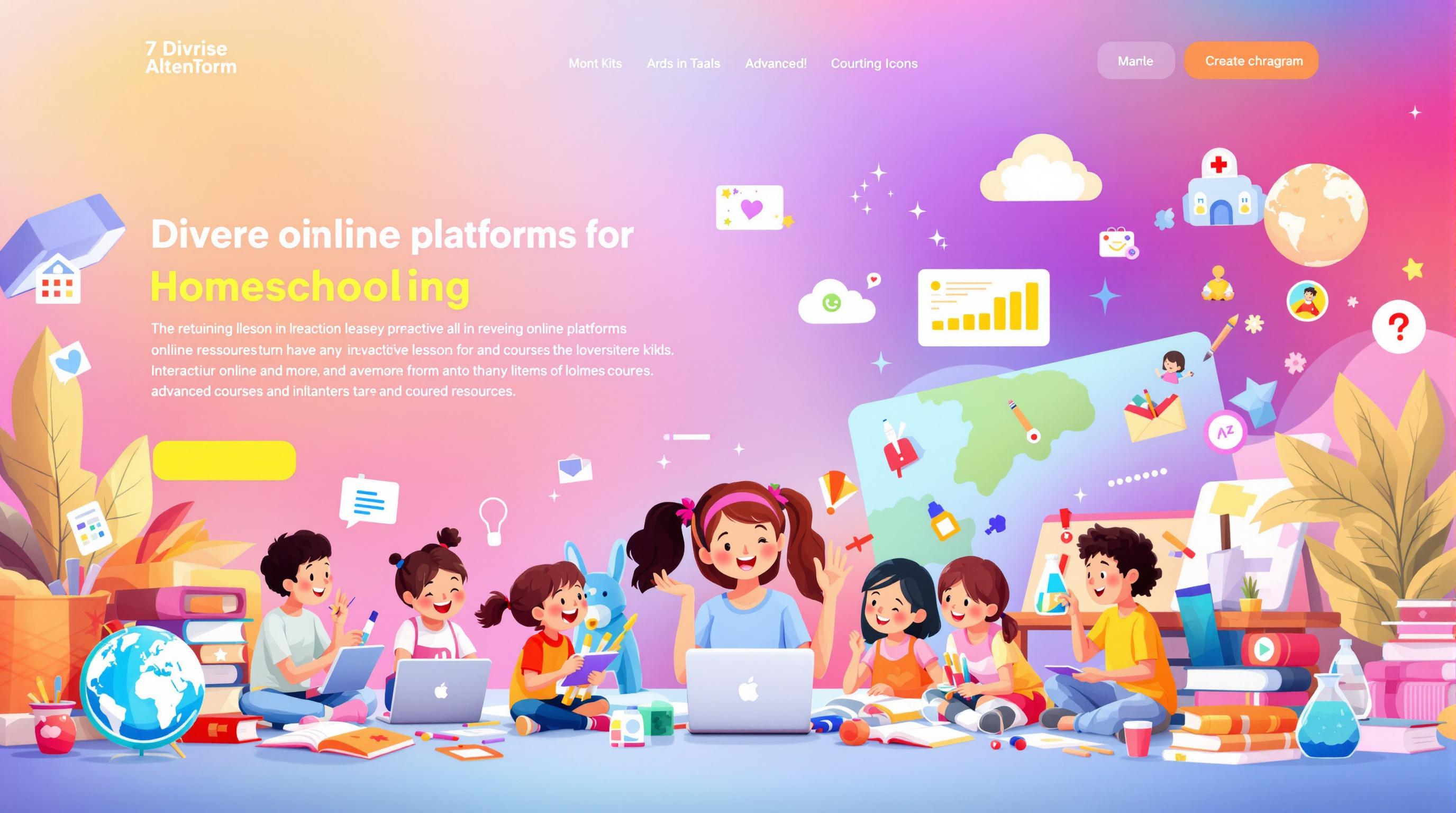Mix-and-match homeschooling lets you pick different curricula for each subject based on what works for your kid. Here's what you need to know:
Key Points:
- Pick curriculum by subject instead of using one complete program
- Switch materials when needed based on your child's progress
- Use different teaching styles for different subjects
- Stay within state requirements while customizing
Quick Guide to Core Subjects:
| Subject | Popular Options | Cost Range |
|---|---|---|
| Math | Saxon Math, Singapore Math, Math-U-See | $40-200/year |
| Reading | All About Learning Press, BookShark | $100-400/year |
| Science | Apologia, BrainPop | $129-300/year |
| History | Sonlight, Torchlight | $50-300/year |
How to Start:
- Check your state's homeschool rules
- Set clear learning goals
- Pick core subjects first
- Add extra subjects like art, music, or languages
- Use free resources to save money
Money-Saving Tips:
- Buy used materials
- Use free online resources
- Start with basics, add more later
- Share costs with other homeschool families
This guide walks you through picking curriculum, setting up a schedule, and adding extra subjects - all while staying within your budget.
Related video from YouTube
How to Start
Starting a mix-and-match homeschool curriculum doesn't have to be scary. Let's break it down:
What Your Family Needs
Think about:
- How much time you can teach each day
- What materials you already have and can afford
- Where you'll do lessons
How Your Child Learns Best
Kids learn differently:
- Visual learners love charts and videos
- Auditory learners prefer listening
- Kinesthetic learners need hands-on stuff
Setting Learning Goals
Clear goals help you pick the right materials:
1. Write a mission statement for your homeschool
2. Create SMART goals (Specific, Measurable, Attainable, Relevant, Time-bound)
| Goal Type | Example |
|---|---|
| Short-term | Learn multiplication tables by December 1st |
| Long-term | Get better at public speaking with weekly family talks |
3. Ask your kid what they want to learn
"Setting goals makes your education yours." - Unknown
Money and Materials Planning
Be smart with your budget:
- Decide how much you can spend
- Buy important stuff first
- Use free resources like Project Gutenberg
- Look for used materials on Facebook or Amazon
"You can create a great learning program without spending a ton." - Amber Stephens, Homeschooling Mom
sbb-itb-fb77983
Main Subjects Guide
Mix-and-match homeschooling lets you customize your child's education. Here's how to tackle core subjects:
Reading and Writing
Blend these resources:
- All About Learning Press for phonics (younger kids)
- BookShark for literature-based learning
- IXL for writing practice
Math Learning
Different approaches help ensure understanding:
| Curriculum | Style | Ideal For |
|---|---|---|
| Saxon Math | Spiral review | College prep |
| Singapore Math | Conceptual | Early years |
| Math-U-See | Mastery-based | Reducing frustration |
| Right Start Math | Hands-on | Building foundations |
"I switched each child to Saxon after Singapore 5 or 6." - Elizabeth, homeschooling parent
Science Teaching
Mix textbooks with hands-on experiments:
- Apologia for Christian-based science
- American Heritage Education Foundation for free lessons
- BrainPop for interactive content ($129-$159/year, two learners)
History and Social Studies
Create a well-rounded program:
- Sonlight for literature-based curricula
- Primary source documents for deeper understanding
- Torchlight Curriculum for geography ($50-$300 per level)
Extra Subjects
Want to spice up your homeschool plan? Let's talk about adding some extra subjects that'll make your kid's education more fun and practical.
Art and Music
Don't stress about making these complicated. Here's how to keep it simple:
- Try "Fine Arts Fridays" - dedicate one day a week to these subjects
- Use art in other lessons - draw pictures for stories or make nature journals for science
- Pick a few composers each year and listen to their music regularly
"In our family, we keep art supplies within easy reach. It reminds us to use them in our everyday lessons", says one homeschooling parent.
Exercise and Sports
Kids need to move! Here are some ideas:
- Join local homeschool sports teams
- Add daily PE to your routine
- Use kid-friendly fitness videos or apps
Learning New Languages
Many colleges want students to know a second language. Here are some popular options:
| Language | Where to Learn |
|---|---|
| Spanish | Duolingo, Rosetta Stone |
| French | Alliance Française courses |
| German | Goethe-Institut online classes |
| Latin | Cambridge Latin Course |
Daily Life Skills
Let's prep kids for the real world:
1. Cooking and Meal Planning
Have your kid plan and cook two meals a week. They'll learn cooking, budgeting, and planning all at once.
2. Money Smarts
Help them budget their allowance or earnings.
3. Home Maintenance
Teach basics like changing light bulbs or checking car oil.
4. Time Management
Show them how to use planners and schedule stuff.
Types of Learning Materials
Homeschooling uses various materials to fit different learning styles. Here's a breakdown:
Books and Workbooks
Old-school printed materials are still big in homeschooling. They give kids a hands-on, screen-free way to learn.
BookShark offers a 36-week program based on literature. It's great for families who want a structured, book-focused approach.
Online Learning Tools
The internet has changed the game for homeschoolers.
IXL Learning provides a PK-12 curriculum with tons of practice problems. At $11.35 per month for Math and English, it's budget-friendly for many families.
Topic-Based Learning
This method zeros in on specific themes.
Curiosity Untamed uses a badge system like scouting to get kids excited about learning. They've got thousands of badges in nine areas, which can guide unit studies.
Story-Based Learning
Books can be the foundation for engaging lessons.
Ivy Kids Kits creates STEM kits inspired by children's books for ages 3-8. Each kit comes with a book and 12-15 hands-on activities.
Video Lessons
Some kids learn better by watching.
K12 offers teacher-developed curriculum with online schooling options. Prices range from $260 to $450 per class.
Learning by Doing
Hands-on activities can boost learning across subjects.
Alison's Montessori provides materials that enhance homeschooling environments, focusing on practical experiences.
When picking materials, think about how your kid learns best. Many families mix different types to create a well-rounded curriculum. The best part of homeschooling? You can tailor it to fit your child's needs.


